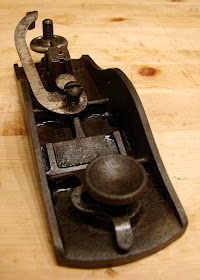This cabinet belongs to some friends down in Oregon. There is something about it that I just love, but there are a lot of things about it I can't quite figure out. Every time I see it, I seem to find some new detail that adds to the puzzle. I'd love to figure out a general history if possible.

I'm pretty sure it is old, maybe as early as the 1700's. I don't have anything solid to base that assumption on, so of course I could be way off. It does have many indicators of age - for example it shows a major repair and some hardware replacement on this drawer front.

The sides of the same drawer show what I assume to be rodent damage. I'm thinking that the repair on the front was for something similar. Also, on the hand cut dovetails, note that the groove for the drawer bottom was left exposed in a pin, rather than being concealed by the tail.


The inside of the upper door panel clearly shows marks from a heavily cambered plane iron.

I really like the inlaid stars.

The crown moulding is a little strange. It's a fairly complex profile, but not smooth at all. It's wavy, like it was carved and not planed. Hmm.

Finally, there are the turned bun feet. Is it normal for the front and rear feet to be different? And I don't know why, but every time I see those feet I think of Bermuda. Where did that come from? I just don't know...

Anyway, if you have any insights or ideas about this cabinet, please comment, I'd love to hear them.


























